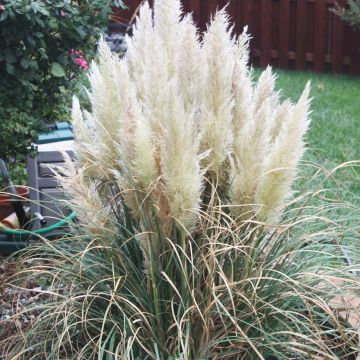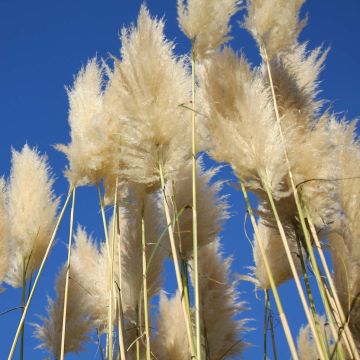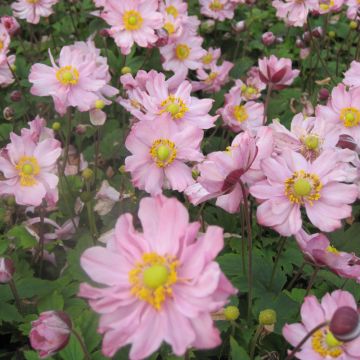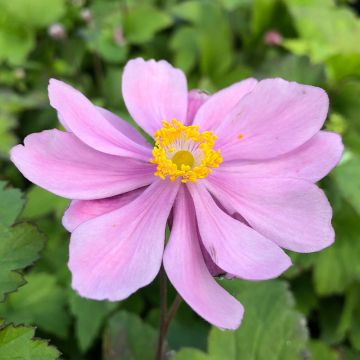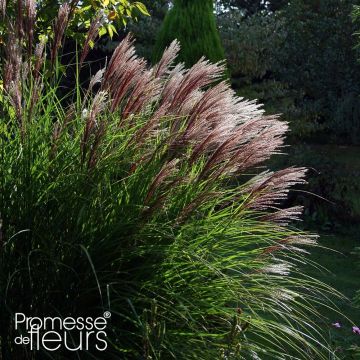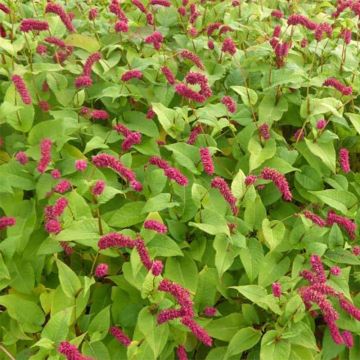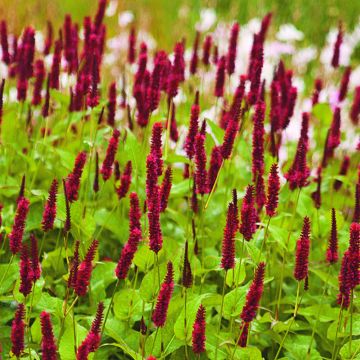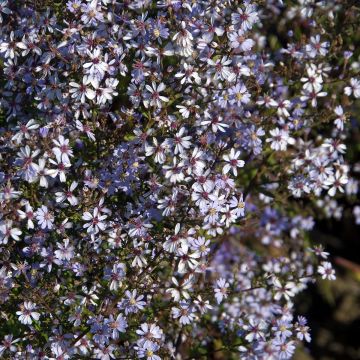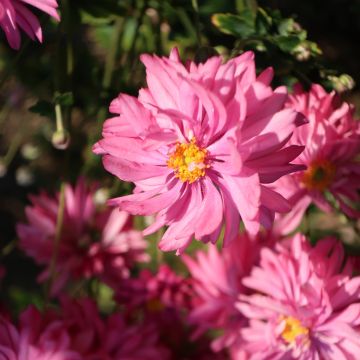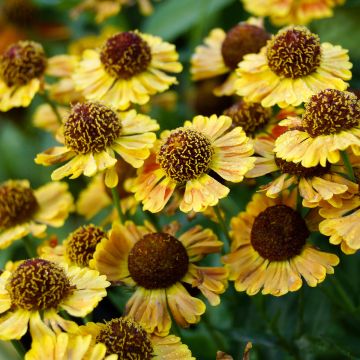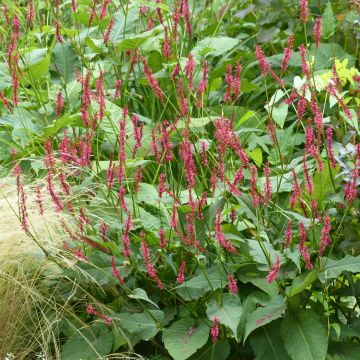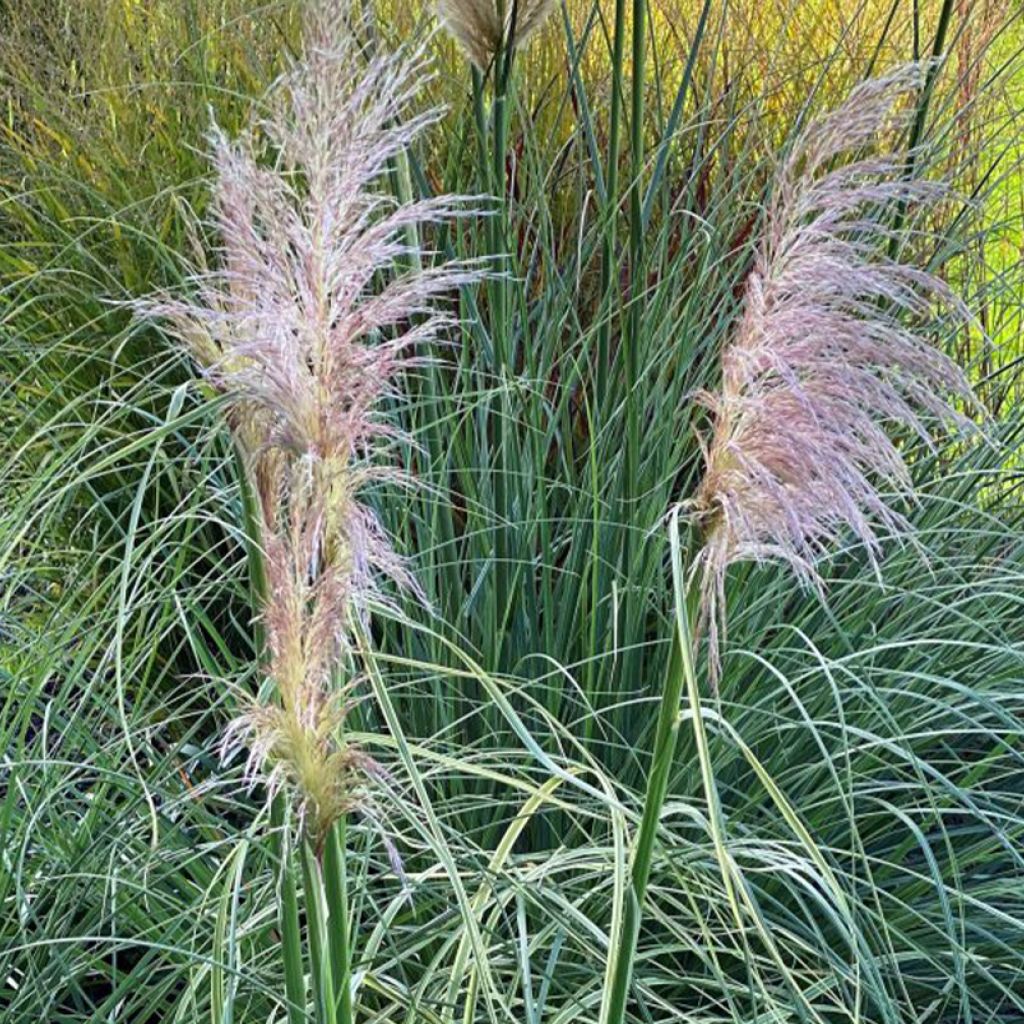

Cortaderia selloana Pink Phantom - Herbe de la pampa
Cortaderia selloana Pink Phantom - Pampas Grass
Cortaderia selloana Pink Phantom
Pampas Grass
This plant carries a 12 months recovery warranty
More information
We guarantee the quality of our plants for a full growing cycle, and will replace at our expense any plant that fails to recover under normal climatic and planting conditions.
From €5.90 for pickup delivery and €6.90 for home delivery
Express home delivery from €8.90.
Does this plant fit my garden?
Set up your Plantfit profile →
Description
IMPORTANT: for the preservation of our natural ecosystems, we have removed this plant from our catalogue as it is considered invasive. It is no longer available for sale.
The Cortaderia selloana 'Pink Phantom' is an unusual variety of Pampas Grass, which combines variegated foliage with a delightful pink flowering in late summer. Impressive, bright, evergreen in winter, this beautiful perennial grass has a lot of presence in the garden, especially since its large plume-like flowers, which have soft silver reflections under the low autumn light, remain decorative for a long time. In addition to its ornamental qualities, the Pampas Grass is easy to grow in the sun, in ordinary soil, even poor, dry in summer, and high in salt.
Cortaderia selloana, also known as Gynerium or Cortaderia argentea, is a large, highly ornamental grass belonging to the Poaceae family. It is native to South America, specifically Argentina and Brazil, where it spreads abundantly by self-seeding along roadsides, paths, stream banks, fallow land, and disturbed areas. This plant is characterised by its great adaptability to the hosting soil, even accepting the semi-arid conditions of subtropical climates. It is a dioecious plant, meaning that there are male and female plants.
The Cortaderia selloana 'Pink Phantom' forms a tuft of foliage that remains evergreen in mild climates during winter. Its narrow, linear leaves are tough, sharp, and rustling. The flowering plant will reach approximately 1.80m (6ft) in height and 80cm (32in) to 1m (3ft) in width. Its habit is slightly arched. The leaves are bluish-grey-green, finely edged with pale yellow to cream yellow. Its beautiful flower heads appear in late summer, in August-September, in the centre of the tuft, in the form of sumptuous soft pink feathery panicles measuring 30 to 50cm (12 to 20in) long, which remain on the plant at least until November, fading. They are borne on sturdy cylindrical stems that are highly resistant to wind. When both male and female individuals are present, the female plants produce a large quantity of seeds that are dispersed by the wind.
This large grass has been present in our gardens since the 1960s. The only point that may be worth mentioning is the improper use that has been made of it. It is true that it looks a bit ridiculous, planted all alone, in the middle of a lawn, when it is so beautiful when used in mass or among shrubs. The Cortaderia selloana Pink Phantom indeed forms large, elegant, and bright tufts, with a very exotic appearance. Truly undemanding, it adapts to all gardens, except perhaps the smallest ones. Designed for large beds, its strong presence brings beautiful structure and a lot of grace, if given enough space to express itself. Pair it with red hot pokers, giant asters, or tall perennial sunflowers. In a wild and untamed atmosphere or a modern and minimalist one, watch it play with the wind and bend under rain showers. In urban areas, Pampas Grass integrates well with its pastel colours, softening the edges without clashing. Magnificent when planted near water features, they can accompany vernonias.
Attention: Classic Pampas Grass, the botanical species, can be invasive in certain regions. Escaping from gardens, it colonises fallow land, sandy environments and wetlands causing significant ecological disturbance. If you live in an affected region, we recommend not planting it. It can be replaced by many other architectural grasses, such as Panic Grasses or Miscanthus.
Report an error about the product description
Flowering
Foliage
Plant habit
Botanical data
Cortaderia
selloana
Pink Phantom
Poaceae
Pampas Grass
Cultivar or hybrid
Other Cortaderia
Planting and care
Cortaderia selloana 'Pink Phantom' appreciates above all good sunlight. Ideally, place it in fairly rich, loose, well-drained soil. However, it will still tolerate poor and mediocre soil, disliking heavy and compact soils, saturated with water in winter. Water abundantly after planting. Then, water regularly during the first year, especially in summer if it is hot and very dry. Once well rooted, this grass tolerates summer drought very well. At the end of winter (March to April), cut off dead leaves, but do not cut back all the foliage. Be careful, the leaves are sharp, it is better to protect your hands with thick gloves. While a young plant may fear intense cold, Pampas grass gains hardiness over the years. A well-established plant will withstand a minimum of -15°C. In cold regions, plant it in a sheltered location, in a well draiing soil, and preferably in spring.
Planting period
Intended location
Care
This item has not been reviewed yet - be the first to leave a review about it.
Late flowering perennials
Haven't found what you were looking for?
Hardiness is the lowest winter temperature a plant can endure without suffering serious damage or even dying. However, hardiness is affected by location (a sheltered area, such as a patio), protection (winter cover) and soil type (hardiness is improved by well-drained soil).

Photo Sharing Terms & Conditions
In order to encourage gardeners to interact and share their experiences, Promesse de fleurs offers various media enabling content to be uploaded onto its Site - in particular via the ‘Photo sharing’ module.
The User agrees to refrain from:
- Posting any content that is illegal, prejudicial, insulting, racist, inciteful to hatred, revisionist, contrary to public decency, that infringes on privacy or on the privacy rights of third parties, in particular the publicity rights of persons and goods, intellectual property rights, or the right to privacy.
- Submitting content on behalf of a third party;
- Impersonate the identity of a third party and/or publish any personal information about a third party;
In general, the User undertakes to refrain from any unethical behaviour.
All Content (in particular text, comments, files, images, photos, videos, creative works, etc.), which may be subject to property or intellectual property rights, image or other private rights, shall remain the property of the User, subject to the limited rights granted by the terms of the licence granted by Promesse de fleurs as stated below. Users are at liberty to publish or not to publish such Content on the Site, notably via the ‘Photo Sharing’ facility, and accept that this Content shall be made public and freely accessible, notably on the Internet.
Users further acknowledge, undertake to have ,and guarantee that they hold all necessary rights and permissions to publish such material on the Site, in particular with regard to the legislation in force pertaining to any privacy, property, intellectual property, image, or contractual rights, or rights of any other nature. By publishing such Content on the Site, Users acknowledge accepting full liability as publishers of the Content within the meaning of the law, and grant Promesse de fleurs, free of charge, an inclusive, worldwide licence for the said Content for the entire duration of its publication, including all reproduction, representation, up/downloading, displaying, performing, transmission, and storage rights.
Users also grant permission for their name to be linked to the Content and accept that this link may not always be made available.
By engaging in posting material, Users consent to their Content becoming automatically accessible on the Internet, in particular on other sites and/or blogs and/or web pages of the Promesse de fleurs site, including in particular social pages and the Promesse de fleurs catalogue.
Users may secure the removal of entrusted content free of charge by issuing a simple request via our contact form.
The flowering period indicated on our website applies to countries and regions located in USDA zone 8 (France, the United Kingdom, Ireland, the Netherlands, etc.)
It will vary according to where you live:
- In zones 9 to 10 (Italy, Spain, Greece, etc.), flowering will occur about 2 to 4 weeks earlier.
- In zones 6 to 7 (Germany, Poland, Slovenia, and lower mountainous regions), flowering will be delayed by 2 to 3 weeks.
- In zone 5 (Central Europe, Scandinavia), blooming will be delayed by 3 to 5 weeks.
In temperate climates, pruning of spring-flowering shrubs (forsythia, spireas, etc.) should be done just after flowering.
Pruning of summer-flowering shrubs (Indian Lilac, Perovskia, etc.) can be done in winter or spring.
In cold regions as well as with frost-sensitive plants, avoid pruning too early when severe frosts may still occur.
The planting period indicated on our website applies to countries and regions located in USDA zone 8 (France, United Kingdom, Ireland, Netherlands).
It will vary according to where you live:
- In Mediterranean zones (Marseille, Madrid, Milan, etc.), autumn and winter are the best planting periods.
- In continental zones (Strasbourg, Munich, Vienna, etc.), delay planting by 2 to 3 weeks in spring and bring it forward by 2 to 4 weeks in autumn.
- In mountainous regions (the Alps, Pyrenees, Carpathians, etc.), it is best to plant in late spring (May-June) or late summer (August-September).
The harvesting period indicated on our website applies to countries and regions in USDA zone 8 (France, England, Ireland, the Netherlands).
In colder areas (Scandinavia, Poland, Austria...) fruit and vegetable harvests are likely to be delayed by 3-4 weeks.
In warmer areas (Italy, Spain, Greece, etc.), harvesting will probably take place earlier, depending on weather conditions.
The sowing periods indicated on our website apply to countries and regions within USDA Zone 8 (France, UK, Ireland, Netherlands).
In colder areas (Scandinavia, Poland, Austria...), delay any outdoor sowing by 3-4 weeks, or sow under glass.
In warmer climes (Italy, Spain, Greece, etc.), bring outdoor sowing forward by a few weeks.

































